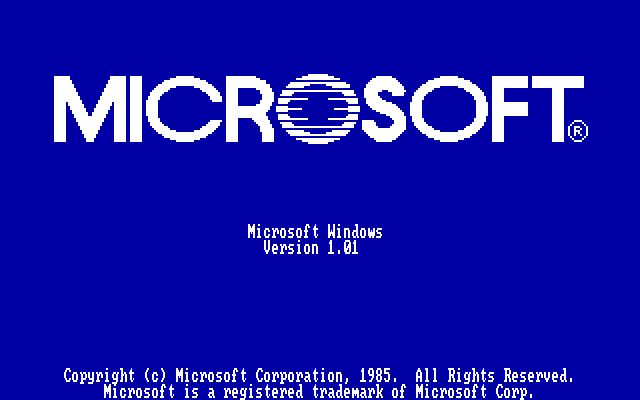The mission statement was simple. To ‘put a computer on every desk in every home’, said Bill Gates at the very advent of Microsoft. And whilst the shape and sizes of computers have changed over the years, for many years now we’ve been living in a world where Bill Gates’ vision has become very much the norm.
And a great deal of thanks should go to the Windows operating system. Launched just shy of thirty years ago, we take a look at how Microsoft Windows has grown up, as Bill Gates’ baby approaches mid-adulthood.
Page Contents [Hide]
Microsoft Windows: 1.0 To 10
IN THE BEGINNING…
On November 20 1985, the very first Windows package, Microsoft Windows 1.0, was launched to a world where IT use in your own home was almost unheard of. Taking its name from the revolutionary computer boxes, or ‘windows’, you were guided through the system via the trusty mouse, as opposed to having to suffer through endless MS DOS commands.

Even in the early days there were parallels with today’s desktop. Paint was there, as was ‘Write’, an early word processor. There was even a game, ‘Reversi’, or ‘Othello’ as it’s otherwise known. And this was all packed into less than one megabyte of space. That’s right, one megabyte. Today you’ll struggle to find a watch with less space than that.
But such were its humble beginnings, and in 1987 the system was improved upon by the launch of Windows 2. Windows 2 first brought the ability to overlap open windows. It added the now familiar control panel, and the first versions of ‘Word’ and ‘Excel’ were born.
Windows was, at least in content, beginning to form what we recognise today. But it wasn’t until Windows 3.0 at the dawn of the ‘90s that computers began to look more like they do today. The system had a more accessible interface and virtual memory to boost the graphical capabilities. It even had Minesweeper for the first time! And soon a CD ROM drive and a sound card were made available, allowing Windows to make its biggest step yet.
THE AGE OF THE INTERNET
Windows 95 was, for many, the first computer you can remember taking pride of place in your home office (and now in the corner of your loft somewhere). This was the age where personal computing really took off and computers became cool. Windows 95 was the first mass advertised Windows system, with the Rolling Stones-led television adverts introducing a home computer that was internet ready for the internet generation.
The online realm was no longer just for research students or businessmen. Thanks to Windows, you could now check your email and browse the ever-growing World Wide Web from the comforts of your own lounge.
It was also easier to install new software and hardware to your computer, vital by the time Windows 98 was launched in June of that year. ‘Works better, plays better’ was the tagline, as DVDs and USBs were the new acronyms in town. Thankfully, Windows 98 was perfectly equipped to support these.
The information age was well and truly upon us, with PCs being increasingly used for entertainment and gaming. And now there was a computer ready for this, and readily available, too.
THE MODERN AGE
After Windows ME and Windows 2000, the home and professional upgrades of 98 for the new millennium, came Windows XP in 2001, a redesigned system no longer built around the 95 engine. The system was immediately easier to navigate, although this had hardly held back Microsoft in the past, with one billion PCs shipped worldwide between the 1970s and the launch of XP.
Online security was beginning to offer a widespread threat to businesses and the average PC user, and XP and its successor, Windows Vista (released in 2006) were ready to counter this.
At the same time, controversially, Windows’ familiar ‘Start’ menu was redesigned, as Vista debuted a new ‘Aero’ visual style. This would remain through Windows 7 (2009), until 2012 when Windows 8 introduced us to the new ‘metro’ interface, which Windows Phone users were already used to. In the age of the tablet, Windows 8 was built so either touch or mouse and keyboard usage were intuitive.
But, with revamps to the system common throughout Windows history, would any of this be successful enough to continue through to Windows 9? Oh. Hang on…
WHAT NOW?
Windows decided to forego sequential logic when, in September 2014, Microsoft unveiled Windows 10. Due to be released in mid-2015, the system maintains two modes making it both touch and remote control ready.
However, in good news for Windows purists, the start menu is back! Meaning that when Windows 1.0 celebrates its 30th anniversary at the time of Windows 10’s launch, it’ll be like being reunited with a familiar friend – a familiar friend who has grown, transformed and enjoyed almost unparalleled success since those early days, all the way back in 1985.
 Tricks Window Technology Zone – Complete Technology Package for Technology News, Web Tricks, Blogging Tricks, SEO, Hacks, Network, Mobile Tricks, Android, Smartphones etc.
Tricks Window Technology Zone – Complete Technology Package for Technology News, Web Tricks, Blogging Tricks, SEO, Hacks, Network, Mobile Tricks, Android, Smartphones etc.



